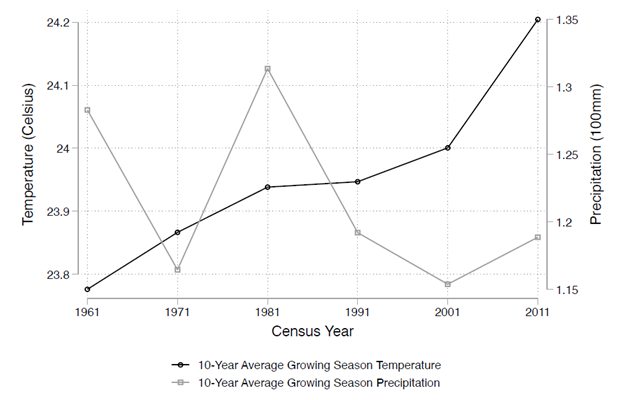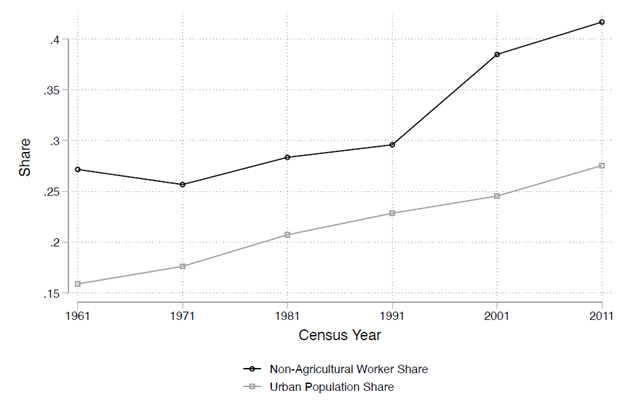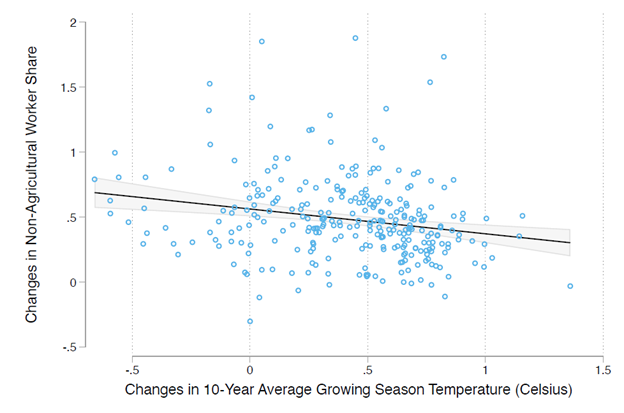
Rising temperatures reduce the proportion of workers in non-agricultural activities and inhibit structural transformation, with effects intensifying in the long run
Developing economies are disproportionately vulnerable to the consequences of climate change, despite contributing relatively less to global carbon emissions. Beyond the more visible repercussions such as extreme droughts and deadly heat waves, the impacts of a warming climate on developing, predominantly agrarian, economies are likely to extend to the productivity of their labour markets.
Developing economies are characterised by large productivity gaps between agricultural and non-agricultural sectors (Gollin et al. 2014), as well as between rural and urban areas (Young 2013). The presence of these gaps suggests that the reallocation of workers across sectors and space may be beneficial for economic development, as it allows for a more efficient allocation of human capital. At the same time, research has documented that higher temperatures have an adverse impact on agricultural incomes and productivity (Schlenker and Roberts 2009, Taraz 2018). This implies that as global temperatures continue to rise, the pace at which workers are reallocated in developing economies - where the vast majority of workers engage in rural agriculture - may be impacted.
In our paper (Liu et al. forthcoming), we investigate the link between climate change and labour reallocation in India over six decades (1951-2011). We examine if rising temperatures impact the movement of workers across sectors and space within local labour markets.
Increasing temperatures, rising non-agricultural employment, and growing urbanisation
Using gridded weather data, we construct decadal average temperature by aggregating monthly weather data during growing season months to ten-year averages. As illustrated in Figure 1, decadal average temperature has increased steadily between 1961 and 2011. At the same time, we do not see a similar monotonic increase in average rainfall over time.
Figure 1: Decadal average temperature and precipitation in India during growing season months, 1961-2011.

Concurrently, India has witnessed a rise in structural transformation and urbanisation over time. Both the share of workers engaged in non-agricultural activities and the share of the total population residing in urban areas have increased monotonically between 1961 and 2011, as illustrated in Figure 2.
Figure 2: Decadal average share of workers engaged in non-agricultural activities and urban population shares in India, 1961-2011.

Bringing these trends together, we plot the relationship between long-run changes in non-agricultural worker share and changes in decadal average temperature between 1961 and 2011 for the 288 Indian districts in our sample. We observe a negative correlation between these in Figure 3, which suggests that rising temperatures could impede the movement of workers out of agriculture.
Figure 3: Correlation between changes in non-agricultural worker share and changes in decadal average temperature in India, 1961-2011.

Empirical approach focusing on medium and long-run climate variations
We rigorously test the robustness of this relationship using two empirical models over different temporal scales. In doing so, we are able to focus on responses to medium and long-term variations in climate. Medium and long-term responses to climate change may differ fundamentally from short-term responses to weather fluctuations because they account for potential adaptation or intensification effects driven by permanent changes in weather. Examining these responses thus allows us to better approximate the impact of future anthropogenic climate change.
We first estimate a panel fixed effects model that exploits decade-to-decade fluctuations in weather. Our identification strategy relies on the assumption — in line with the recent climate economy literature (Dell et al. 2014) — that conditional on district and region-by-time fixed effects, decade-to-decade fluctuations in weather are quasi-random. We consider the results from this model to be capturing medium-term responses to climate change.
Next, we estimate a long differences model, in the spirit of Burke and Emerick (2016), that exploits variation in long-term temperature trends over the span of our sixty-year data set, conditional on regional trends. We consider this as capturing long-term responses to climate change.
Notably, changes in average climate may impact labour reallocation differently in the long run if medium-run effects are either mediated through adaptation or compounded through intensification over time. A comparison of medium and long-term responses will thus allow us to elicit potential adaptation or intensification effects in response to average climate over longer time periods.
Rising temperatures inhibit structural transformation, with effects amplified in the long run
We find that rising temperatures inhibit structural transformation in Indian districts. The magnitude of this effect is economically meaningful; a 1°C increase in mean decadal temperature in an average district leads to an 8.2% decline in the share of the labour force engaged in non-agricultural activities. At the same time, we fail to find any detectable impact of rising temperatures on urbanisation rates. This latter result is in line with Henderson et al. (2017), who document a similar null effect of adverse changes in climate on urbanisation in Sub-Saharan Africa.
Next, we find that the adverse effects of rising temperatures on structural transformation are amplified when we examine impacts over a longer time frame. This suggests that not only do individuals fail to adapt to sustained high temperatures, they also experience intensification effects of warming over time.
Declining aggregate demand as a leading mechanism driving these effects
What could explain these adverse effects of rising temperatures on structural transformation? We explore several potential mechanisms that could underlie these effects. We first confirm that the well-established negative relationship between temperature and agricultural productivity holds in our empirical context. Consistent with the literature, we find that a 1°C increase in current growing season temperature is associated with a 5.9% reduction in crop yields.
Given that agriculture is a primary source of income for a substantial share of households in developing economies, productivity shocks to the agricultural sector can also be important for other sectors in the economy in general equilibrium. Under this scenario, adverse agricultural productivity shocks could reduce demand for non-agricultural labour through a contraction in demand for local non-agricultural goods and services. We coin this mechanism ‘local demand effects’.
We find strong evidence of local demand effects playing an important role. First, we document a decline in both food and non-food consumption among households in response to rising temperatures, which suggests a contraction in demand for local non-agricultural goods and services. Second, we show that the decline in the non-agricultural labour share is driven primarily by a reduction in the share of workers engaged in the services sector, which is by nature a non-tradable sector of the economy.
We also investigate several other mechanisms through which rising temperatures could impact structural transformation. For example, rising temperatures could impede labour reallocation under a scenario where households are constrained in their ability to borrow and save, and also face costs to relocating. A decline in agricultural income would subsequently make it more difficult for workers to afford the costs associated with moving across sectors and space. Rising temperatures could also lead to changes in cultivation practices, through land consolidation or shifts to more labour-intensive crops, for example. We find weak evidence of these alternative mechanisms playing an important role.
Implications for policy
Our paper contributes to the growing literature that aims to understand sectoral and spatial reallocation of workers in response to slow-onset changes in climate. The bulk of the existing literature has focused on short-run variation in weather to estimate effects. We show that medium and long-run responses to climate differ fundamentally from short-run responses. We find that higher temperatures inhibit structural transformation in Indian districts, with effects intensifying in the long run. These findings have important policy implications both in India, and in other developing economies that are particularly vulnerable to climate change. For example, it highlights the importance of policies and interventions that will make agricultural incomes less susceptible to higher temperatures.
References
Burke, M and K Emerick (2016), “Adaptation to climate change: Evidence from US agriculture”, American Economic Journal: Economic Policy 8(3): 106–140.
Dell, M, B F Jones, and B A Olken (2014), “What do we learn from the weather? The new climate–economy literature”, Journal of Economic Literature 52(3): 740–798.
Gollin, D, D Lagakos, and M E Waugh (2014), “The agricultural productivity gap”, The Quarterly Journal of Economics 129(2): 939-993.
Henderson, J V, A Storeygard, and U Deichmann (2017), “Has climate change driven urbanization in Africa?”, Journal of Development Economics 124: 60-82.
Schlenker, W and M J Roberts (2009), “Nonlinear temperature effects indicate severe damages to US crop yields under climate change”, Proceedings of the National Academy of Sciences 106(37): 15594–15598.
Taraz, V (2018), “Can farmers adapt to higher temperatures? Evidence from India”, World Development 112: 205–219.
Young, A (2013), “Inequality, the urban-rural gap, and migration”, The Quarterly Journal of Economics 128(4): 1727–1785.



